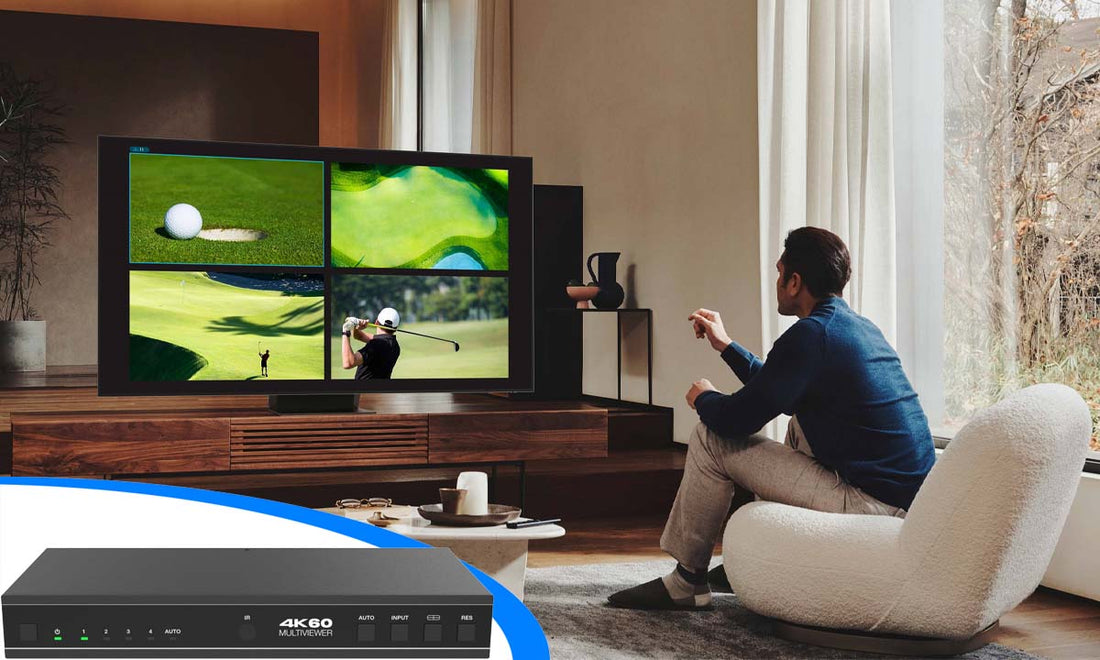
The Ultimate Guide to HDMI Multiviewer: Features, Benefits, and Considerations
Share
In today's fast-paced world, where multiple video sources need to be monitored simultaneously, HDMI multiviewers have become essential tools. These devices allow users to display multiple HDMI video sources on a single screen, making them ideal for control rooms, broadcasting, surveillance, and multimedia presentations. However, with a wide range of options available in the market, choosing the right HDMI multiviewer for your specific needs can be a daunting task. In this comprehensive guide, we will explore the essential features, benefits, and considerations to help you make an informed purchase decision.
Understanding HDMI Multiviewers:
HDMI multiviewers are powerful devices designed to accept multiple HDMI inputs from various sources like computers, cameras, DVD players, or gaming consoles. They combine these inputs into a single output displayed on a monitor or television. By providing simultaneous viewing of multiple video sources, HDMI multiviewers enhance productivity, simplify monitoring, and improve the overall visual experience.
Types of HDMI Multiviewers:
- Standalone HDMI Multiviewers:
Standalone multiviewers are independent devices that accept multiple HDMI inputs and provide a dedicated output. They are versatile and suitable for most applications. Standalone multiviewers come in various configurations, such as 2-input, 4-input, 8-input, or even larger matrices, allowing you to connect multiple video sources. According to the number of different input sources, usually they have a variety of multiviewer display modes, such as 2-screen display, 3-screen display, 4-screen display, etc. Each display mode can also set the screen size, position, aspect ratio, etc.
- Software-based HDMI Multiviewers:
Software-based multiviewers are applications that can be installed on a computer. They utilize the computer's display output to create a multiviewer setup. This type of multiviewer offers flexibility and cost-effectiveness but requires a reliable computer system to handle the processing and display requirements.
Key Specifications to Consider:
When choosing an HDMI multiviewer, several key specifications need to be taken into account:
- Number of HDMI Inputs:
Determine the number of video sources you need to connect simultaneously and ensure that the multiviewer supports an adequate number of HDMI inputs. It is recommended to consider future expansion needs as well.
- Output Resolution:
Check the supported output resolution to ensure compatibility with your display device. Look for options that offer 1080p or higher resolutions for optimal visual quality. Some advanced multiviewers even support 4K or 8K resolutions for ultra-high-definition displays. Some devices also have advanced EDID management capabilities that can adjust the format of the HDMI output signal to different display specifications.
- Display Modes and Layouts:
Evaluate the available display modes and layouts offered by the multiviewer. Look for customizable options that allow you to arrange and configure video sources according to your preferences. Common display modes include 2x2, 3x3, quad-split, picture-in-picture (PiP), and full-screen mode.
- Audio Handling:
some multiviewer can supports audio extraction and embedding, allowing you to manage audio sources alongside video sources. Usually they can support optical digital and analog audio outputs. Look for features like audio volume control, audio channel selection, and adjustable audio delay to ensure synchronized audio setting.
- Control Options:
Consider the available control options such as panel button controls, OSD (on-screen display), remote control, or web-based interfaces for easy operation and management. Some multiviewers offer advanced control capabilities like RS-232, LAN, or IP control, allowing integration with control systems for centralized management.
- Scalability and Expandability:
If your requirements may grow in the future, consider multiviewers that offer scalability and expandability. Look for features like cascading or daisy-chaining, which enable the connection of multiple multiviewers for larger video setups.
- Monitoring and Control Features:
Investigate additional monitoring and control features that the multiviewer provides. These may include on-screen display (OSD) for source identification, video signal quality indicators, alarms and notifications, and advanced video processing capabilities.
Benefits of HDMI Multiviewers:
HDMI multiviewers offer numerous benefits that enhance productivity and streamline operations. Understanding these advantages can help you realize the full potential of these devices. Some key benefits include:
- Efficient Monitoring:
Multiviewers enable real-time monitoring of multiple video sources on a single screen, eliminating the need for multiple displays and reducing clutter. Operators can easily keep an eye on different video feeds, making it ideal for applications such as security surveillance, control rooms, or live event monitoring.
- Enhanced Decision Making:
The ability to view multiple video sources simultaneously allows operators to make quick and informed decisions. Whether it's analyzing multiple camera angles, monitoring different computer screens, or comparing content side by side, HDMI multiviewers improve response time and overall efficiency.
- Space and Cost Savings:
By eliminating the need for multiple displays and reducing cable clutter, HDMI multiviewers save valuable space and reduce equipment costs. With a single monitor or TV screen, you can achieve a consolidated view of multiple sources, making it an efficient and cost-effective solution.
- Increased Productivity:
HDMI multiviewers enhance productivity by providing a consolidated view of critical information. Users can multitask effectively by monitoring various sources simultaneously, leading to improved workflow efficiency and better resource utilization.
- Improved Visual Experience:
With HDMI multiviewers, you can enjoy a seamless switching and visually appealing display of multiple video sources. By customizing layouts, choosing display modes, and arranging sources according to your preferences, you can create an optimized visual experience tailored to your specific needs.
Tips for Making an Informed Purchase Decision:
- Assess Your Requirements:
Clearly define your specific needs, including the number of video sources, desired display configurations, and compatibility with existing equipment. Consider factors like the size of your workspace, future expansion plans, and the complexity of your video setup.
- Read Customer Reviews and Ratings:
Research and read reviews from reputable sources and customers to gain insights into the performance, reliability, and user-friendliness of different multiviewer models. Look for feedback regarding ease of installation, software stability, picture quality, and customer support.
- Seek Expert Advice:
Consult with industry experts, AV integrators, or professionals who have experience with HDMI multiviewers. They can provide valuable recommendations based on your unique requirements and offer insights into the latest technologies and trends.
- Compare Prices and Warranty:
Compare prices from different vendors and consider the warranty and after-sales support offered. While it's important to find a product within your budget, ensure that you prioritize quality, reliability, and long-term support.
- Request Demos or Trials:
Whenever possible, request demos or trials of the HDMI multiviewers you are considering. This hands-on experience will allow you to evaluate the user interface, performance, and compatibility with your video sources.
Conclusion:
Choosing the right HDMI multiviewer requires careful consideration of features, benefits, and individual requirements. By understanding the different types of multiviewers, evaluating key specifications, and considering the benefits they offer, you can make an informed purchase decision. Remember to assess your specific needs, read reviews, seek expert advice, compare prices, and request demos to ensure that the chosen HDMI multiviewer aligns with your requirements. With the right HDMI multiviewer, you can enhance productivity, streamline monitoring, and improve your overall visual experience.
